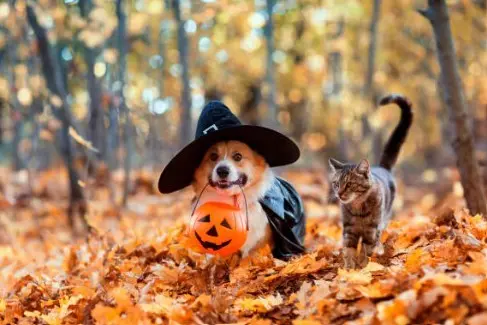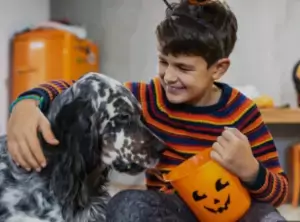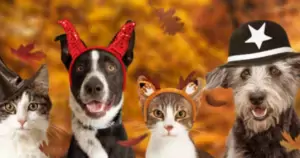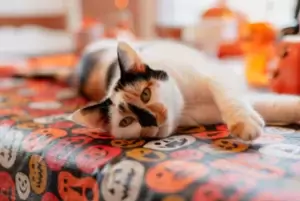Halloween is a holiday for tricks, treats, and potentially, trouble. Learn how to protect your pet from common Halloween hazards—and a trip to UrgentVet—by reviewing the following sinister scenarios and their potential outcomes—the close call (i.e., trick), the safe choice (i.e., treat), and trouble (i.e., a pet emergency).
Scenario #1: Your pet is frightened by trick-or-treaters at the front door
Trick (close call): You’ve been observing your pet’s body language and are familiar with the subtle changes that precede their panic, including their ears swiveled to the side or flattened against their head, or a full-body crouch. Sometimes, their darting eyes have revealed the white portion or sclera (i.e., “whale eye”). Therefore, anticipating that your pet may try to escape, you calmly pick them up or guide them by the collar to a quiet, secure room.
Treat (safe option): You know your pet is easily startled by unfamiliar visitors and environmental changes, and may try to bolt, so you confine them to a quiet room or crate away from the front door and other holiday disturbances. You give your pet a positive distraction, such as a Kong filled with pet-safe ingredients, a lickable mat smeared with plain yogurt, or a long-lasting chew, so they will not be stressed and anxious while they are confined. However, if your pet generally enjoys visitors, keeping them leashed as you greet trick-or-treaters may be a better option.
No matter which option you choose for your pet, you should also take the extra precaution of ensuring your pet’s identification tags are legible and current and their microchip is registered and the contact information up-to-date.
Trouble (emergency): Instead of retreating further inside your home, your pet panics, bolts through the open front door, and disappears into the dark night. You spend the evening calling and searching for your pet, with the help of several neighbors.
Scenario #2: You find your pet eating from spilled Halloween candy
Trick: Knowing your pet could flee or choke when they see your panic, you calmly clip on their leash or call your pet away. You pick up the wrapper remnants, and collect the candy bowl. Then, you call your local UrgentVet or the ASPCA Animal Poison Control Center hotline. You answer a few questions about the kind and amount of candy your pet potentially consumed, and the veterinary team explains that your pet did not ingest a toxic dose and recommends that you monitor your pet for digestive upset. You may be advised to bring your pet to UrgentVet for decontamination (i.e., induced vomiting), an early stage outpatient intervention that can prevent toxicosis-related illness and injury.
Treat: Anticipating your pet’s penchant for trouble, you strategically purchase Halloween candy that does not contain toxic ingredients (e.g., dark chocolate, raisins, macadamia nuts, or xylitol). You store the candy in closed containers or on high shelves that your pet cannot access so they cannot indulge. You also ensure your children’s candy is kept in a central location (e.g., the kitchen).
Trouble: Because your pet is behaving normally and doesn’t appear sick, you postpone a call to the veterinarian and monitor your pet at home. Unfortunately, toxicosis signs in pets are often delayed and become apparent hours or days later when the pet’s condition is serious. A couple of days later, your pet has critical signs, including continuous vomiting, seizures, and unresponsiveness, and you rush them to the nearest UrgentVet or veterinary emergency center.
Scenario #3: Your pet debuts their Halloween costume, but receives mixed reviews
Trick: You can’t wait to see your dog or cat in their cute costume, so you have a dress rehearsal before the Halloween festivities. You take a few pictures for social media, and then get involved with your Halloween preparations and leave your pet unsupervised. When you check on your pet, they are stressed and limping. The excess fabric along your pet’s chest has trapped their foreleg and prevented normal movement. You remove the costume and reassure your anxious pet.
Treat: In the weeks before Halloween, you check your pet’s costume for fit and comfort. Tight costumes can restrict natural movement and breathing, while loose clothing can pose a tripping hazard. You make the necessary adjustments, secure any dangling accessories, and ensure no part of the costume (e.g., hats, wigs, or headpieces) obstructs your pet’s vision.
If your pet seems stressed, unhappy, or otherwise uncomfortable, you will shop for a more enjoyable replacement, such as a decorative collar, bow tie, or bandana.
Trouble: After only 10 minutes, your pet’s adorable astronaut helmet slips down over their eyes. Your pet attempts to get the helmet off so they can see, but in their panic, they stagger too close to the staircase, lose their balance and tumble down the stairs, injuring their back, knees, or hips. They are in so much pain, you realize they need treatment at UrgentVet.
Turn potential Halloween tricks and troubles into treats this October by paying close attention to your pet’s behavior and emotional needs, keeping harmful candy and foods out of reach, and ensuring they always wear current identification.
If your All Hallow’s Eve turns into a pet owner’s worst nightmare, don’t fear—every UrgentVet location is staffed with knowledgeable, compassionate experts who are ready to help in any non-life threatening pet emergency after hours. Find a location near you or check-in online—because your pet can’t wait to feel better.






